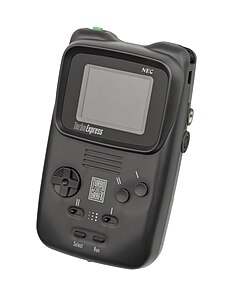
The Atari Lynx is a hybrid 8/16-bit fourth-generation hand-held game console released by Atari Corporation in September 1989 in North America and 1990 in Europe and Japan. It was the first handheld game console with a color liquid-crystal display. Powered by a 16 MHz 65C02 8-bit CPU and a custom 16-bit blitter, the Lynx was more advanced than Nintendo's monochrome Game Boy, released two months earlier. It also competed with Sega's Game Gear and NEC's TurboExpress, released the following year.

The Game Boy Advance (GBA) is a 32-bit handheld game console developed, manufactured and marketed by Nintendo as the successor to the Game Boy Color. It was released in Japan on March 21, 2001, in North America on June 11, 2001, in the PAL region on June 22, 2001, and in mainland China as iQue Game Boy Advance on June 8, 2004. The GBA is part of the sixth generation of video game consoles. The original model was followed in 2003 by the Game Boy Advance SP, a redesigned model with a frontlit screen and clamshell form factor. A newer revision of the SP with a backlit screen was released in 2005. A miniaturized redesign, the Game Boy Micro, was released in September 2005.

A handheld game console, or simply handheld console, is a small, portable self-contained video game console with a built-in screen, game controls and speakers. Handheld game consoles are smaller than home video game consoles and contain the console, screen, speakers, and controls in one unit, allowing people to carry them and play them at any time or place.

The PC-FX is a 32-bit home video game console developed by NEC and Hudson Soft. It was released in 1994 and discontinued in February 1998, as NEC's final home video game console. Based on the NEC V810 CPU and CD-ROM, it was intended as the successor to the PC Engine. Unlike its predecessor, the PC-FX was only released in Japan.
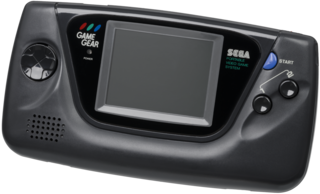
The Game Gear is an 8-bit fourth generation handheld game console released by Sega on October 6, 1990, in Japan, in April 1991 throughout North America and Europe, and during 1992 in Australia. The Game Gear primarily competed with Nintendo's Game Boy, the Atari Lynx, and NEC's TurboExpress. It shares much of its hardware with the Master System, and can play Master System games through the use of an adapter. Sega positioned the Game Gear, which had a full-color backlit screen with a landscape format, as a technologically superior handheld to the Game Boy.

The TurboGrafx-16, known as the PC Engine outside North America, is a home video game console designed by Hudson Soft and sold by NEC Home Electronics. It was the first console marketed in the fourth generation, commonly known as the 16-bit era, though the console has an 8-bit central processing unit (CPU) coupled with a 16-bit graphics processor. It was released in Japan in 1987 and in North America in 1989. In Europe, the console is known as the PC Engine, after the Japanese model was imported and distributed in the United Kingdom and France from 1988. In Japan, the system was launched as a competitor to the Famicom, but the delayed United States release meant that it ended up competing with the Sega Genesis and later the Super NES.

The WonderSwan is a handheld game console released in Japan by Bandai. It was developed by Gunpei Yokoi's company Koto Laboratory and Bandai, and was the last piece of hardware Yokoi developed before his death in 1997. Released in 1999 in the sixth generation of video game consoles, the WonderSwan and its two later models, the WonderSwan Color and SwanCrystal were officially supported until being discontinued by Bandai in 2003. During its lifespan, no variation of the WonderSwan was released outside of Japan.
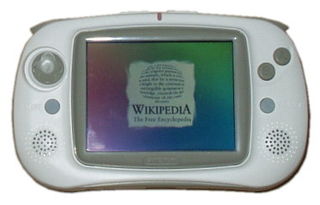
The GP32 is a handheld game console developed by the South Korean company Game Park. It was released on November 23, 2001, in South Korea and distributed in some parts of Europe.

The Game Boy Advance SP, released in Japan on February 14, 2003, is a sixth-generation handheld game console developed, released, and marketed by Nintendo that served as an upgraded version of the original Game Boy Advance. The "SP" in the name stands for "Special". It is the penultimate console in the Game Boy Advance product line before the Game Boy Micro, which was released in September 2005.
In the history of video games, the fourth generation of video game consoles, more commonly referred to as the 16-bit era, began on October 30, 1987, with the Japanese release of NEC Home Electronics' PC Engine. Though NEC released the first console of this era, sales were mostly dominated by the rivalry between Sega and Nintendo across most markets: the Sega Mega Drive and the Super Nintendo Entertainment System. Cartridge-based handheld consoles became prominent during this time, such as the Nintendo Game Boy (1989), Atari Lynx (1989), Sega Game Gear (1990) and TurboExpress (1990).

The PC Engine SuperGrafx, also known as simply the SuperGrafx, is a fourth-generation home video game console manufactured by NEC Home Electronics and released in Japan in 1989. It is the successor system to the PC Engine, released two years prior. Originally known as the PC Engine 2 during production stages, it was purported as a true 16-bit home console, featuring improved graphics and audio capabilities over its predecessor.
Bonk, known as PC-Genjin in Japan and as PC Kid or BC Kid in PAL territories, is a video game character and former mascot for NEC's PC Engine/TurboGrafx-16 video game console. Three platform games featuring the character appeared on the PC Engine/TurboGrafx-16, as well as two spin-offs featuring Air Zonk. The protagonist is a bald caveman named Bonk who attacks using his comically large head.
The history of video game consoles, both home and handheld, had their origins in the 1970s. The concept of home consoles used to play games on a television set was founded by the 1972 Magnavox Odyssey, first conceived by Ralph H. Baer in 1966. Handheld consoles bore out from electro-mechanical games that had used mechanical controls and light-emitting diodes (LED) as visual indicators. Handheld electronic games had replaced the mechanical controls with electronic and digital components, and with the introduction of Liquid-crystal display (LCD) to create video-like screens with programmable pixels, systems like the Microvision and the Game & Watch became the first handheld video game consoles, and fully realized by the Game Boy system.
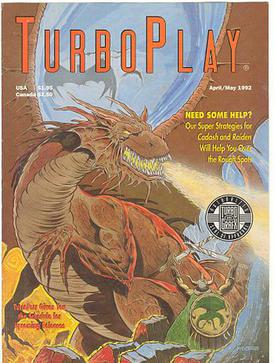
TurboPlay Magazine is a bi-monthly, U.S.-based video game magazine which was published by L.F.P. from June/July 1990 through August/September 1992. It was available via subscription only. A total of 14 issues were released, on schedule. TurboPlay exclusively covered NEC's line of video game consoles, especially the North American models: TurboGrafx-16, TurboGrafx-CD (TG-CD), Turbo Duo (DUO) and the handheld TurboExpress. NEC's SuperGrafx also received some minor coverage.

The TurboDuo is a fourth-generation video game console developed by NEC Home Electronics and Hudson Soft for the North American market. The TurboDuo was test-marketed in Los Angeles in October 1992, before a nationwide rollout in May 1993. It is the North American version of the Japanese PC Engine Duo game console which was released in September 1991.
A dedicated console is a video game console that is limited to one or more built-in video game or games, and is not equipped for additional games that are distributed via ROM cartridges, discs, downloads or other digital media. Dedicated consoles were very popular in the first generation of video game consoles until they were gradually replaced by second-generation video game consoles that use ROM cartridges.
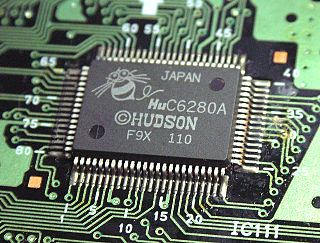
The HuC6280 8-bit microprocessor is Japanese company Hudson Soft's improved version of the WDC 65C02 CPU, an upgraded CMOS version of the popular NMOS-based MOS Technology 6502 8-bit CPU, manufactured for Hudson by Seiko Epson and NEC. The most notable product using the HuC6280 is NEC's TurboGrafx-16 video game console.
The Virtual Console was a line of downloadable video games for Nintendo's Wii and Wii U home video game consoles and the Nintendo 3DS family of systems.

Gunhed, known as Blazing Lazers in North America, is a vertically scrolling shooter game by Hudson Soft and Compile, based on the Japanese film Gunhed. The title was released in 1989, for the PC Engine in Japan and re-skinned for the TurboGrafx-16 in North America, with Gunhed unofficially imported for the PC Engine in Europe. In the game, a fictional galaxy is under attack by an enemy space armada called the Dark Squadron, and this galaxy's only chance for survival is the Gunhed Advanced Star Fighter, who must destroy the Dark Squadron and its Super Weapons. The gameplay features fast vertical scrolling and a wide array of weapons for the player to use.
The TurboGrafx-16 Mini, also known as the PC Engine Mini in Japan and PC Engine CoreGrafx Mini in Europe, is a dedicated home video game console by Konami modeled on NEC's TurboGrafx-16, which was designed by Hudson Soft, a video game developer which Konami acquired in 2012. The Mini emulates the original console's 8-bit hardware. The Japanese model contains 58 games in total while the international models contain 57. The Mini was originally set to be released worldwide on March 19, 2020, exclusively through Amazon, but was delayed everywhere except for Japan because of the COVID-19 pandemic. It was shipped in North America on May 22, 2020, and in Europe on June 5, 2020.


